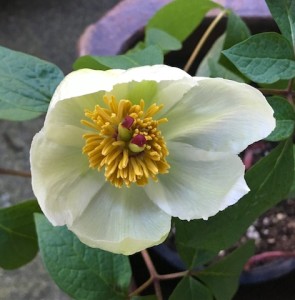November is one of the a best times of year to plant deciduous trees. Even after their leaves are gone, trees with interesting bark stand out, adding new interest to the winter garden. Many deciduous trees also bloom in early spring, before most other flowering plants—a welcome sight after a long winter.
The Witch Hazel (Hamamelis) is adorned with a profusion of delicate, fluffy flowers in late winter making it one the first deciduous trees to bloom in the Pacific Northwest. The brilliant sunshine-yellow flowers of the Arnold Promise Witch Hazel (Hamamelis x intermedia ‘Arnold Promise’) turn up as early as January to glow against a backdrop of snow.
The peeling cinnamon-brown branches of the Paperbark Maple (Acer griseum) pop when set against a backdrop of the cool Blue Ice Arizona Cypress (Cupressus arizonica var. glabra ‘Blue Ice’) or the Donard Gold Monterey Cypress (Cupressus macrocarpa ‘Donard Gold’). The exotic-looking bright green trunks of Acer davidii (Snakebark Maple) have off-white striations that catch the winter light, especially against a backdrop of contrasting branches and foliage. Cornus alba ‘Sibirica’ (Red Twig Dogwood) is a bush that features tight clumps of vertical coral-red branches that stand out during the wintertime when they are in full view. A red twig has the most impact when planted in masses as a background plant, allowing it to visually recede during the times of year when it looks uninteresting.
The bare trunks and branches of deciduous trees cast dramatic shadows in the low winter sun. You can get a similar effect by lighting them from below or stringing them with delicate white holiday lights. On a large property, plant deciduous trees in groves for a dramatic affect. For courtyards or in-city patios, use one tree in a planter to create a focal point. Pair with early blooming bulbs such as Galanthus (snowdrop) and perennial Helleborus for bright spots of color that relieve the post-holiday doldrums.
Here’s a hardscaping tip: If a stone patio or walkway is part of your winter garden plan, considering incorporating silvery quartzite that sparkles as it reflects light. You might not be spending much time outdoors this winter, but being able to look out the window and see an inspirational winter garden can lift the spirits even on the darkest days.
If you’re looking for more ideas, please contact me for a design consultation to learn about landscape design or the best plants for any spot in your garden.



